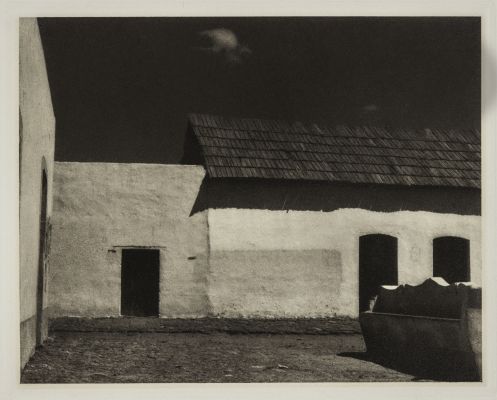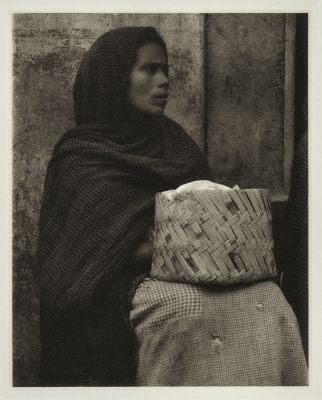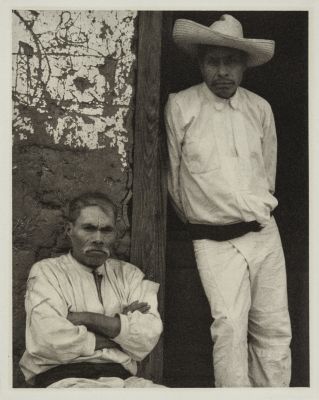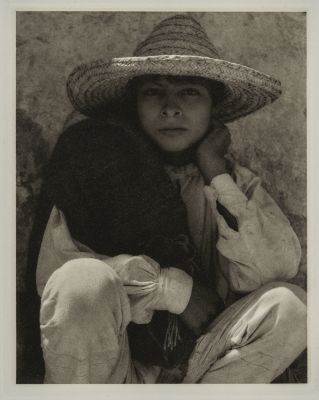
Title
Young Woman and Boy – TolucaArtist
Strand, Paul (American, 1890-1976)Key FigurePublication
Photographs of MexicoDate
1940 plate (1933 negative)Process
PhotogravureAtelier
Photogravure and Color Company, New YorkImage Size
6.12 x 5 in
This portfolio is one of the most potent and impressive collections of fine photogravure ever produced. Strand’s photographs, taken during an extended stay in Mexico in 1932, sensitively depict the country’s streets, architecture, religious statuary and inhabitants. Such post-revolutionary subjects also appeared in the work of contemporaneous Mexican painters such as Diego Rivera. The photogravures in Photographs of Mexico were hand printed with great skill by Charles Furth of the The New York Photogravure and Color Company in an edition of 250 copies. Strand customized the inks, fine tuning the color depending on the image, almost as if he were printing them in his darkroom. Strand also experimented with and personally applied a Damar varnish to the prints making them prone to darkening but ultimately warming and enhancing them. I imagine Strand knew and predicted the turning of the varnish. In 1967, Strand reissued the work as The Mexican Portfolio, in a larger edition printed by Andersen Lamb Company, of Brooklyn, and with a varnish that has not yellowed. Both editions were printed by the most skilled gravure pressmen of the time, producing flawless photogravures that are rich and extremely detailed.
In the autumn of 1932, Paul Strand had separated from both his mentor, Alfred Stieglitz and his wife Rebecca. With the growing need to concentrate exclusively on his still photography, he contacted Carlos Chávez, then chief of the Department of Fine Arts in the secretariat of Education in Mexico, to help arrange an official invitation to work in Mexico. Strand claimed that he abandoned his usual working methods at the border. He was reading Marx at this time and considered his work a criticism of capitalism a system I detest, so all the portraits are of peasants and tend to valorize them. I began to find that the shibboleths of time were not true for me. It was always said that you had to really know a place before start working in it, otherwise you would do something very superficial. Another shibboleth was that you can’t make a portrait of a person unless you know that person…. these shibboleths went out the window.
Strand made several trips to various Mexican states during the period of 1932-1934. The photographs acted as a transition from formalism in landscape and portraiture to a new social realism imbued with a fine art approach and technique. Sequencing played a major roll in the portfolio, the first image is Landscape, Near Saltillo is a distant view of a white adobe structure seen through cactus and brush. The sequence moves from architectural studies of churches and vernacular buildings to the interior of the church and the religious statues, to the portraits of the unnamed people who inhabit these places. The sequence moves back and forth, back and forth so that the viewer begins to understand the lives of these people.
The actual production of the portfolio was first suggested by Lee Strasberg of the Group Theatre and published under the imprint of Virginia Stevens, Strand’s second wife and an actress with the Group Theatre. Strand said of the portfolio The thing that was original about this portfolio was that it was a conscious attempt to see if one could make reproductions which were so close to the originals – the originals being platinum prints – that they were good enough to be framed. That I think had not been done before. And I chose gravure as the one medium that I thought was possible to do that job.
References
Stange, Maren, Robert Adams, and Alan Trachtenberg. Paul Strand: Essays on His Life and Work. New York: Aperture, 1990.
Roth Andrew et al. The Book of 101 Books : Seminal Photographic Books of the Twentieth Century. PPP Editions in Association with Ruth Horowitz LLC 2001.
Parr Martin and Gerry Badger. 2004. The Photobook : A History. Volume I. London: Phaidon.











